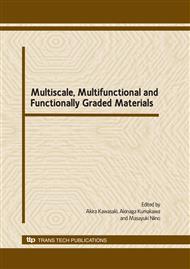p.361
p.367
p.373
p.379
p.387
p.393
p.401
p.407
p.413
Creep Properties of SUS304 Steel by Small Punch Creep Tests
Abstract:
Creep behavior of SUS304 stainless steel is studied by small punch creep (SP-C) test. Series of SP-C testing for SUS304 stainless steel are carried out at 600°C. The time dependence of the central deflection is obtained by the SP-C testing at different load level and the creep deflection curves are quantitatively similar to those observed in conventional uniaxial creep testing. In this paper, an analytic approach based on Chakrebarty’s membrane-stretch model is used to interpret the SP-C test method. The relationship between specimen central deflection and equivalent strain is deduced, and the relationship between load and equivalent stress are established. The creep stress exponent of SUS304 stainless steel is determined by the theory formula and the data obtained in the SP-C testing. Comparison of the creep stress exponent of the Norton equations in SP-C testing and conventional creep testing is performed. The results show that the creep stress exponent is well consistent with conventional experimental results.
Info:
Periodical:
Pages:
387-392
Citation:
Online since:
October 2009
Authors:
Price:
Сopyright:
© 2010 Trans Tech Publications Ltd. All Rights Reserved
Share:
Citation:


